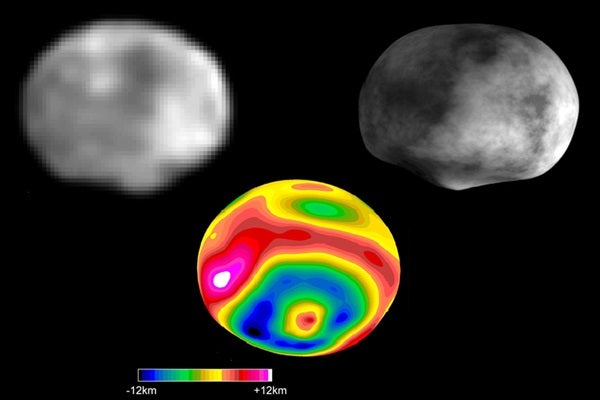The image from Dawn’s framing cameras was taken May 3 when the spacecraft began its approach and was approximately 752,000 miles (1.21 million km) from Vesta. The asteroid appears as a small, bright pearl against a background of stars. Vesta also is known as a protoplanet because it is a large body that almost formed into a planet.
“After plying the seas of space for more than a billion miles, the Dawn team finally spotted its target,” said Carol Raymond from NASA’s Jet Propulsion Laboratory (JPL) in Pasadena, California. “This first image hints of detailed portraits to come from Dawn’s upcoming visit.”
Vesta is 330 miles (530 km) in diameter and the second most massive object in the asteroid belt. Ground- and space-based telescopes obtained images of the bright orb for about 2 centuries, but with little surface detail.
Mission managers expect Vesta’s gravity to capture Dawn in orbit July 16. To enter orbit, Dawn must match the asteroid’s path around the Sun, which requires precise knowledge of the body’s location and speed. By analyzing where Vesta appears relative to stars in framing camera images, navigators will pin down its location and enable engineers to refine the spacecraft’s trajectory.
Dawn will start collecting science data in early August at an altitude of approximately 1,700 miles (2,700 km) above the asteroid’s surface. As the spacecraft gets closer, it will snap multi-angle images, allowing scientists to produce topographic maps. Dawn will later orbit at approximately 120 miles (200 km) to perform other measurements and obtain closer shots of parts of the surface. Dawn will remain in orbit around Vesta for 1 year. After another long cruise phase, Dawn will arrive in 2015 at its second destination, Ceres, an even more massive body in the asteroid belt.
Gathering information about these two icons of the asteroid belt will help scientists unlock the secrets of our solar system’s early history. The mission will compare and contrast the two giant asteroids shaped by different forces. Dawn’s science instruments will measure surface composition, topography, and texture. Dawn also will measure the tug of gravity from Vesta and Ceres to learn more about their internal structures. The spacecraft’s full odyssey will take it on a 3-billion-mile (5 billion km) journey, which began with its launch September 2007.
The image from Dawn’s framing cameras was taken May 3 when the spacecraft began its approach and was approximately 752,000 miles (1.21 million km) from Vesta. The asteroid appears as a small, bright pearl against a background of stars. Vesta also is known as a protoplanet because it is a large body that almost formed into a planet.
“After plying the seas of space for more than a billion miles, the Dawn team finally spotted its target,” said Carol Raymond from NASA’s Jet Propulsion Laboratory (JPL) in Pasadena, California. “This first image hints of detailed portraits to come from Dawn’s upcoming visit.”
Vesta is 330 miles (530 km) in diameter and the second most massive object in the asteroid belt. Ground- and space-based telescopes obtained images of the bright orb for about 2 centuries, but with little surface detail.
Mission managers expect Vesta’s gravity to capture Dawn in orbit July 16. To enter orbit, Dawn must match the asteroid’s path around the Sun, which requires precise knowledge of the body’s location and speed. By analyzing where Vesta appears relative to stars in framing camera images, navigators will pin down its location and enable engineers to refine the spacecraft’s trajectory.
Dawn will start collecting science data in early August at an altitude of approximately 1,700 miles (2,700 km) above the asteroid’s surface. As the spacecraft gets closer, it will snap multi-angle images, allowing scientists to produce topographic maps. Dawn will later orbit at approximately 120 miles (200 km) to perform other measurements and obtain closer shots of parts of the surface. Dawn will remain in orbit around Vesta for 1 year. After another long cruise phase, Dawn will arrive in 2015 at its second destination, Ceres, an even more massive body in the asteroid belt.
Gathering information about these two icons of the asteroid belt will help scientists unlock the secrets of our solar system’s early history. The mission will compare and contrast the two giant asteroids shaped by different forces. Dawn’s science instruments will measure surface composition, topography, and texture. Dawn also will measure the tug of gravity from Vesta and Ceres to learn more about their internal structures. The spacecraft’s full odyssey will take it on a 3-billion-mile (5 billion km) journey, which began with its launch September 2007.










